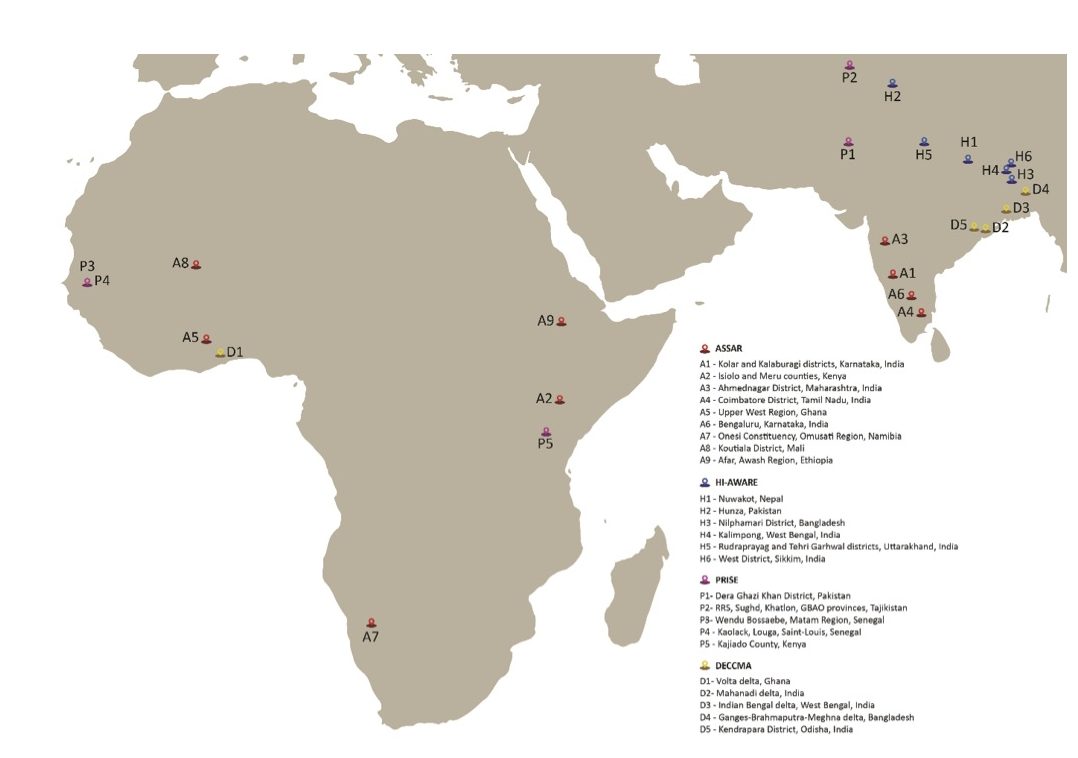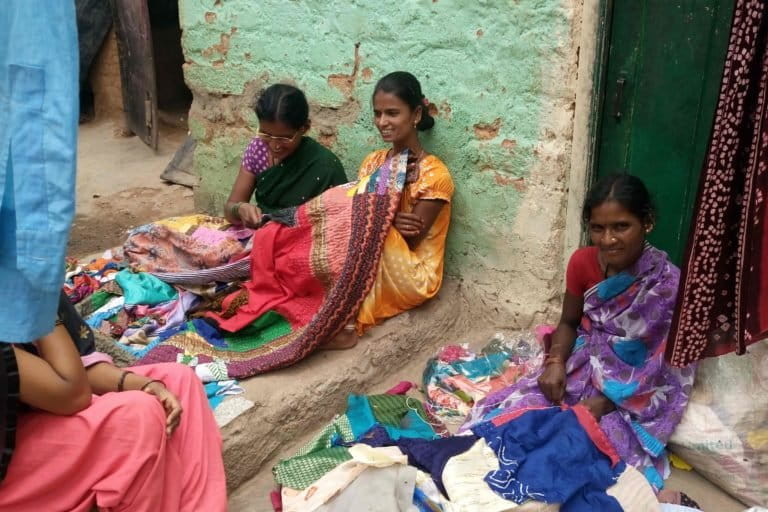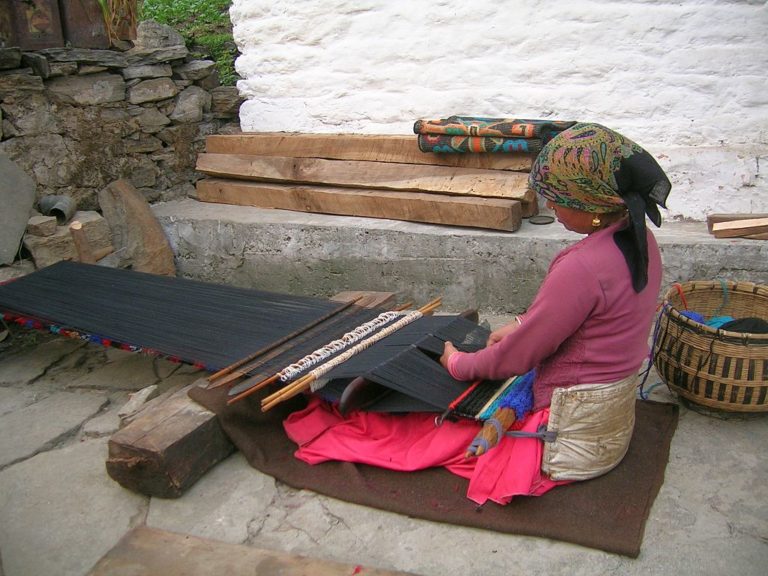- Male migration and poor working conditions for women combine with institutional failure or poverty to hamper women’s ability to adapt to climate variability in Asia and Africa. There are exceptions too.
- Climate change is a threat multiplier, which means that climate change often exacerbates reasons for migrating.
- Addressing barriers in creative ways could potentially strengthen adaptive capacities, and enable more effective adaptation. As an example, researchers underscore the continuance of the Mahatma Gandhi National Rural Employment Guarantee Act and the public distribution system for cereals in India.
- According to the World Migration Report 2020, despite growing recognition in recent years of the need to better integrate migration into global climate and environmental mechanisms, and for climate change mechanisms to incorporate human mobility aspects, there is still more work to be done in the development of cohesive policy approaches.
In Karnataka’s drought-prone Kolar, men started moving out of agriculture about a decade ago, to find jobs off-the-field. The area, once considered the world’s second deepest gold mine with two centuries of mining history, saw an exodus of farmers who moved on to non-agrarian work in the metropolis of Bengaluru and urban sprawls of small towns nearby in the semi-arid south Indian state.
Meanwhile, women back home reported the additional burden that fell on them as a result of male outmigration.
“Agriculture is no more profitable and feasible, and men are moving out of agriculture. So again, the fieldwork falls on us women,” said a woman during a focus group discussion in Kolar documented in a 2019 study, authored by Chandni Singh of the Indian Institute for Human Settlements.
Another lamented: “When the men migrate, we women tend to open shops to sell perishable goods. But we don’t have any place to store the goods and incur a loss. We also don’t have physical space to sit and sell their produce, and regularly have to pay off the police and Panchayat member to let us.”
Karnataka’s Kolar is one of the 25 qualitative case studies across climate change hotspots in Africa and Asia that feed into a fresh study examining women’s ability to adapt effectively to climate change which researchers dubbed as a “threat multiplier.”
It involved researchers from the U.K., Nepal, India, Pakistan and South Africa spanning hotspots India, Nepal, Pakistan, Bangladesh, Tajikistan in Asia and Kenya, Ghana, Namibia, Mali, Ethiopia, Senegal in Africa.
“Migration in dryland, semi-arid parts of India, as well as mountain regions, has been happening because of multiple reasons. Environmental stress is one of the reasons for people to migrate. People also migrate to fulfill aspirations, earn better, and for education. We are arguing that climate change is a threat multiplier, which means that whatever reasons you have for migrating, climate change often exacerbates those reasons,” Chandni Singh, a co-author of the new study, told Mongabay-India.
Lead author Nitya Rao, of University of East Anglia’s School of International Development, said in a statement that male migration and poor working conditions for women combine with institutional failure or poverty to hamper women’s ability to adapt to climate variability and change in Asia and Africa.
“If these barriers are addressed in creative ways, [it] could potentially strengthen adaptive capacities, and enable more effective adaptation,” Rao said.

Can improving women’s agency help communities cope with climate change?
The case locations chosen to understand climate change impacts on vulnerable communities range across three distinct agro-ecological regions: semi-arid regions in Africa and parts of South and Central Asia, deltas in Africa and South Asia and glacier- and snowpack-dependent river basins in the Himalayas.
“In a sense, women do have voice and agency, as they are actively engaging in both production and reproduction, yet this is not contributing to strengthening longer-term adaptive capacities, or indeed their wellbeing,” said Rao.
The researchers argue that environmental stress weakens women’s agency even when household structures and social norms are supportive, or legal entitlements available. This leads to household strategies that place increasing responsibilities and burdens on women, especially those who are young, less educated, and belonging to lower classes, or marginal castes and ethnicities.
“We wanted to test the hypothesis that if you improve women’s agency (their decision-making ability, their voice in communities or households and power to influence decisions) then it can help communities cope with harsher climatic conditions better. We found it is true,” Singh explained.
But there are several riders to that.
“For example, in places of extreme environmental stresses, such as in Kolar in Karnataka, this hypothesis doesn’t work. Women are often the most vulnerable to climate change in hotspots such as Kolar where water scarcity is driving low agricultural returns and male outmigration. In places like these, we’ve seen men migrate out to search for jobs afield and women alone have to take care of livestock, children, and farms, increasing their work burdens,” elaborated Singh.
Similarly, in one of the Pakistan-based case studies, after monsoon rains and floods destroyed the cotton crop, a young woman noted, “Men can easily migrate for work whereas we have to stay here (at home) to take care of the family.”
In semi-arid Kenya, the study records, when men moved away with livestock, women lost control over milk for consumption and sale and had to work harder to provide nutritious food for their children.
“Climate change acting together with other stressors is reducing women’s agency. Women say they would like to migrate to cities but they are constrained because of these additional responsibilities,” said Singh.
Co-author Anjal Prakash, Associate Professor and Associate Dean at TERI School of Advanced Studies underscored that understanding women’s agency is key to building resilience to climate change. “The level of their agency contributes to how resilient the women are towards a changing climate,” Prakash told Mongabay-India.
As the climate comes unhinged, the material and subjective well-being aspects of the gendered nature of migration come to the fore-when a family moves together, women start working and their material wellbeing improves.
Singh observed that the families begin earning more as a household unit. But they weren’t satisfied with the lives they were leading in the city. “When we asked them, women said they don’t have time for leisure, time to chat with their neighbours. So their subjective well-being or life satisfaction had often gone down,” she said.
Migrating from one climate risk to another
Tracking rural to urban migration in India’s Karnataka unpacked another dimension − on one hand, they escape drought but on the other hand, they are forced to live on the frontline of events such as localised flooding in cities.
“When you move from the rural area, you are adapting to climate change. If you look at the urban side of migration, migrants are employed in insecure and often unsafe jobs such as construction work, as labourers in small industries, drivers, etc. Also, they tend to enter the city through peri-urban areas, living in informal settlements with poor infrastructure. This exposes them to localised flooding and subsequent health risks,” said Singh.
In Asia, one of the fastest urbanising regions in the world, 37 percent of its population lived in cities in 2000 and the proportion is projected to reach more than 50 percent by 2025. City after city in India has experienced floods in recent years including Chennai, Mumbai, Delhi, and Kolkata.
Singh called for targetted programmes for providing migrants with safety nets as they move from rural to urban areas and enter new climate risks. Particularly, a focus on gender, e.g. mobile creches for working mothers could be useful, she said.

Strengthening social security measures and collective action
But there are positive outcomes as well − men took on roles that were traditionally meant for women.
“For example, work by my colleague Prathigna Poonacha shows that when a woman picks up a job as domestic help, gendered norms of household duties are upturned. If she is not able to take care of the child, the man steps up to look after the child. As more people move into cities, the implications of these intra-household shifts on adaptive capacity will are critical to capture,” said Singh.
Further, Saudamini Das of the Institute of Economic Growth in New Delhi commented that at a macro level, women seem to be worse off, but the micro situation may be different. “There are many cases where women have done well and have taken up the adaptation challenges strongly,” Das told Mongabay-India.
In the aftermath of cyclone Hudhud in Andhra Pradesh, it was seen that women-headed households are seen to maintain their assets in such a way that they suffered less damage than male households compared to their income.
“Such cases are few but mostly found in marginalised communities where women have formed groups or have been managing their households because husbands are away or not there,” Das said.
The findings of the study have implications for the effective implementation of multilateral agreements such as the United Nations Framework Convention on Climate Change, through its Gender Action Plan, and commitments to gender-responsive adaptation as outlined in the Paris Agreement, along with the Sendai Framework for Disaster Risk Reduction and the Sustainable Development Goals.
These agreements require insights into what builds the adaptive capacity of women and men in specific contexts in order to support sustainable, equitable, and effective adaptation.
Effective social protection, such as the universal public distribution system for cereals in India, or pensions and social grants in Namibia, can contribute to relieving immediate pressures on survival, creating some room for maneuver.
“Social security measures such as Mahatma Gandhi National Rural Employment Guarantee Act and public distribution system for cereals in India should continue,” stressed Singh.
Secondly, rather than creating competition among individuals and households, such universal benefits can support processes that strengthen collective action at the community level. This, however, cannot always be done on the ‘cheap’; investments are needed to enable better and more sustainable management of resources. Women’s Self Help Groups are often presented as solutions, yet they are confronted by the lack of resources, skills, and capacity to help their members effectively meet the challenges they confront, the researchers note in a statement.
The ‘Hindu Kush Himalaya (HKH) Assessment: Mountains, Climate Change, Sustainability, and People’ report released by the International Centre for Integrated Mountain Development (ICIMOD), earlier this year, highlighted that “existing laws and policies do not support the multiple ways in which women negotiate their roles in households, communities, and the market.”
Migration in the Himalayan region continues to be a significant livelihood strategy, and there is a growing understanding that it can also open up new opportunities for development. It highlighted that emerging research shows that a large number of climate change affected households in this region have been using labour migration as one of the many adaptation tools.
“Since the beginning of the new millennium, an ever-increasing number of women are participating in labour migration in some of the HKH countries,” the report added. It batted for policymakers to approach migration “not as a challenge, but instead seek ways to mainstream it into climate change adaptation, disaster risk reduction, and policy processes and programmes.”
The recently released World Migration Report 2020 mentions that there has been growing recognition in recent years of the need to better integrate migration into global climate and environmental mechanisms, and for climate change mechanisms to incorporate human mobility aspects.
While significant steps have been taken to ensure that the issue of human mobility in the context of environment and climate change receives greater consideration
at the international level, its inherent sensitivities (securitisation, protection, and adaptation and climate risk management) means that there is still more work to be done in the development of cohesive policy approaches.
Banner: Internal migrants in the Himalayan countries need new social protection measures. Photo by Shyamal L./Wikimedia Commons.
CITATION
Rao, N., Mishra, A., Prakash, A., Singh, C., Qaisrani, A., Poonacha, P., … & Bedelian, C. (2019). A qualitative comparative analysis of women’s agency and adaptive capacity in climate change hotspots in Asia and Africa. Nature Climate Change, 1-8.
